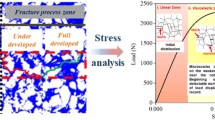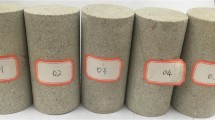Abstract
The results of experimental long-term tension and bending tests carried out on four natural stones formely widely used in Italian traditional building (a white-veined Carrara marble, the “pietra Serena” and “Pietraforte” sandstones, and the Piobbico-Cesana limestone) are presented. The tests consisted of applying continually different fractions of the “instantaneous” fracture loads and monitoring the strain evolution of the specimens until a time-delayed fracture was reached. A typical three-stage creep response was obtained in all the tests. At the same time, a 60% reduction in tensile and bending strength was observed in relation to testing periods not much longer than one year. A phenomenological constitutive model is proposed for analytically reproducing the experimental viscoplastic behaviour. Furthermore, a creep time-to-rupture function giving direct estimates of the strength decay effects is provided, with a view to technical applications. The results of the identification analyses carried out to calibrate the characteristic parameters of the above laws are also reported.
Résumé
Dans cet article, on présente les résultats d'un certain nombre d'essais à long terme (en traction simple et en flexion) effectués sur quatre sortes de pierres naturelles utilisées très souvent autrefois en Italie pour la construction (le marbre blanc de Carrara, deux sortes de grès, la pierre de Florence et la “Pietraforte”, ainsi que sur la pierre calcaire de Piobbico-Cesana). Les essais ont été réalisés en appliquant de façon continue aux éprouvettes différentes fractions de charges “instantanées” de rupture, en relevant l'évolution de la déformation jusqu'à la rupture. En général, tous les essais ont montré un comportement caractérisé par les trois phases classiques du fluage. En même temps, on a constaté une diminution de 60% de la résistance, tant à la traction qu'à la flexion, par rapport à une durée d'essais peu supérieure à un an. Cet article présente un modèle constitutif phénoménologique permettant d'analyser le comportement visco-plastique observé. On indique ici, en vue d'applications techniques, une fonction de fluage qui perment l'évaluation directe des effets de la diminution de la résistance mécanique. Enfin, on présente les résultats de l'identification effectuée pour l'étalonnage des paramètres caractéristiques des lois analytiques qui règlent le modèle constitutif.
Similar content being viewed by others
References
Blasi, C. and Sorace, S., ‘Cracks in marble due to a long-term small tensile stress configuration’, in ‘Structural conservation of stone masonry: diagnosis, repair and strengthening’, Proceedings of an International Conference, Athens, October 1989 (ICCROM, Rome, 1990), pp. 283–290.
Borri, A. and Sorace, S., ‘FE analysis strategies for structural materials with small tensile strength,’J. Press. Vess. Techn. ASME 115 (1993) 156–163.
Binda, L., Molina, C. and Tatti, C. M., ‘Evaluation criteria of materials vulnerability’ (in Italian), Proceedings of 6th Italian Conference on Earthquake Engineering, October 1993, (University of Perugia, Perugia, 1993) pp. 639–650.
Malesani, P. P. and Vannucci, S. A., ‘Research on degradation of stones’ (in Italian), Tuscan Academy of Sciences and Letters (Leo Olschky, Florence, 1974).
Malesani, P. P. and Vannucci, S. A., ‘Decay of pietra Serena and Pietraforte Florentine building stones: petrographic observations’,Studies in Cons. 19 (1) 36–50.
Malesani, P. P. and Monechi, S., ‘Electron microscope study of microtexture in the Scaglia Umbra formation’,Riv. Ital. Paleont. 81 (1) 45–56.
‘Acceptance of natural building stones’ (Italian Technical Standards, R.D. 16 November 1939).
Mellor, M. and Hawkes, I., ‘Measurement of tensile strength by diametral compression of discs and annuli’,Engng. Geol. 5 (1971) 173–225.
Hardy, H. R. and Jayaraman, N. I., ‘Hoop-stress loading-a new method of determining the tensile strength of rock’,J. Soc. Petrol. Eng. 12 (1972) 246–252.
Lawn, B. and Wilshaw, R., ‘Indentation fracture: principles and applications’,J. Mater. Sci. 10 (1975) 1049–1081.
Barla, G. and Innaurato, N., ‘Indirect tensile testing of anisotropic rocks’,Roc Mech. 5 (1973) 215–230.
Barber, D.J., ‘Regimes of plastic deformation-processes and microstructures: an overview’, in ‘Deformation processes in minerals, ceramics and rocks’, Proceedings of an International Meeting July 1987 (Unwin Hyman, London, 1990) pp. 138–178.
Weertman, J., ‘Dislocation climb theory of steady-state creep’,Trans. Am. Soc. Metals 61 (1970) 145–168.
Ecob, R. C. and Bilde-Sørensen, J. B., ‘The structural basis for creep relations’, in ‘Constitutive relations and their physical basis’, Proceedings of 8th InternationalSymposium on Metallic Materials Science, June 1987 (Risø National Laboratory, Roskilde, 1987), pp. 67–82.
Courtney, T.H., ‘Mechanical behavior of materials’, 1st edn (McGraw-Hill, New York, 1990), Chapters 3 and 7.
Poirier, J.-P., ‘Creep of crystals’, 1st edn (Cambridge University Press, Cambridge, 1985).
Sellars, C. M., ‘Recrystallization of metals during hot deformation,’Phil. Trans. R. Soc. Lond. A228 (1978) 147–158.
Tullis, J. and Yund R.A., ‘Dynamic recrystallization in feldspars: a mechanism for ductile shear formation’,Geology,13 (1985) 238–241.
Lemaitre, J. and Chaboche, J.-L., ‘Mechanics of Solid Materials’, 2nd edn (Cambridge University Press, Cambridge, 1990).
Kachanov, L. M., ‘On the time to failure under creep conditions’ (in Russian),Izv. Akad. Nauk. SSR 8 (1958) 26–31.
Kirby, S. H., ‘Rheology of the lithosphere’,Rev. Geophys. Space Phys. 21 (1983) 1458–1487.
Heard, H. C. and Raleigh, C. B., ‘Steady-state flow in marble at 500–800°C’,Geol. Soc. Am. Bull. 83 (1972) 935–956.
Karato, S., ‘Defects and plastic deformation in olivine’, in ‘Rheology of Solids and of the Earth’ (Oxford University Press, Oxford, 1989), pp. 176–208.
Schmid, S. M., ‘Rheological evidence for changes in the deformation mechanism of Solenhofen limestone towards low stresses’,Tectonoph. 31 (1976) T21-T28.
Schmid, S. M., Boland, J. N. and Paterson, M. S., ‘Superplastic flow in fine-grained limestone’,Tectonoph. 43 (1977) 257–291.
Matsumoto, K. and Toriumi, M., ‘Mechanical states of the upper mantle under island arcs inferred from the microstructures of periodotite xenoliths’, in ‘Rheology of Solids and of the Earth’ (Oxford University Press, Oxford, 1989), pp. 374–392.
Rabotnov, Y.N., ‘Creep rupture’, Proceedings of 12th International Congress on Applied Mechanics, Standford, September 1969 (Springer, Berlin, 1969), pp. 137–144.
Author information
Authors and Affiliations
Rights and permissions
About this article
Cite this article
Sorace, S. Long-term tensile and bending strength of natural building stones. Mat. Struct. 29, 426–435 (1996). https://doi.org/10.1007/BF02485993
Issue Date:
DOI: https://doi.org/10.1007/BF02485993




